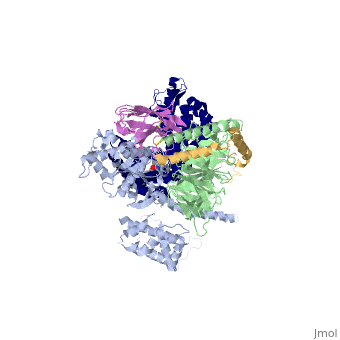Beta2 adrenergic receptor-Gs protein complex
Beta2 adrenergic receptor-Gs protein complexBeta2 adrenergic receptor-Gs protein complex
IntroductionG protein-coupled receptors (GPCRs) are a large family of protein receptors which have seven-transmembrane helices and are found over a large array on eukaryotic cells. These receptors take major part in a multitude of signal transduction pathways, including amongst others responses to hormones and neurotransmitters, sensing light, taste and smell, and many more. These receptors are also involved in many different types of diseases and are the target of almost 50% of current medical drugs. The Beta-2 Adrenergic Receptors are a type of GPCRs which are activated by catecholamine hormone ligands such as adrenaline (epinephrine). These receptors are responsible for many of the adrenaline related (“fight-or-flight”) responses and functions, and are used as a common model system for the GPCR family. GPCRs bind their ligand and overcome a conformational change which allows a Guanine nucleotide-binding protein (G protein) to detach from the cellular end of the receptor and start the different signal transduction pathways. Since these receptors have seven transmembrane helices as well as inner and outer cell regions, they are very difficult to purify and crystalize. Some crystal structures have been determined for the inactive receptors as well as for the G proteins that they bind. PDB entry 3sn6 is the first structure of the full complex of the Beta 2 Adrenergic Receptor bound to Gs in their active state, and it provides the first high-resolution insight into the mechanism of signal transduction across the plasma membrane by a GPCR. Complex structureThe overall structure shows the b2AR (dark blue) bound to an agonist (in spheres) along with a T4 lysozyme fused to its amino terminus in order to facilitate crystallization. The receptor interacts with Gas (light blue). Gas together with Gb (light green) and Gc (gold) constitute the heterotrimeric G protein Gs. A Gs-binding nanobody which also facilitates crystallization (pink) binds the G protein between the a and b subunits. G-Protein-GPCR IntercationsThe a5-helix of Gas docks into a cavity formed on the intracellular side of the receptor by the opening of transmembrane helices 5 and 6. Within the transmembrane core, the interactions are primarily non-polar - an exception involves . As the a5-helix exits the receptor it forms a network of polar interactions with TM5 and TM3. Receptor residues , thereby structurally linking receptor–G protein interactions with the highly conserved DRY motif of the b2AR. G-Protein CycleThe figure shows the G Protein cycle [1] - an extracellular agonist binding to the β2AR leads that enable the Gs heterotrimer to bind the receptor. GDP is released from the α subunit upon formation of β2AR–Gs complex. The GTP binds to the nucleotide-free α subunit resulting in dissociation of the α and βγ subunits from the receptor. The subunits regulate their respective effector proteins adenylyl cyclase (AC) and Ca2+ channels. The Gs heterotrimer reassembles from α and βγ subunits following hydrolysis of GTP to GDP in the α subunit.
G-Protein variabilityThe Gαs subunit consists of two domains, the Ras domain (αRas) and the α-helical domain (αAH). Both are involved in nucleotide binding. A big discovery made thanks to this structure is that the G alpha subunit has large variability between its GTP bound (active) and nucleotide free states, where See Also
|
| ||||||||||
ReferencesReferences
- ↑ Rasmussen SG, DeVree BT, Zou Y, Kruse AC, Chung KY, Kobilka TS, Thian FS, Chae PS, Pardon E, Calinski D, Mathiesen JM, Shah ST, Lyons JA, Caffrey M, Gellman SH, Steyaert J, Skiniotis G, Weis WI, Sunahara RK, Kobilka BK. Crystal structure of the beta2 adrenergic receptor-Gs protein complex. Nature. 2011 Jul 19;477(7366):549-55. doi: 10.1038/nature10361. PMID:21772288 doi:10.1038/nature10361
